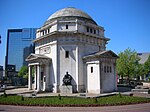Newman Brothers Coffin Furniture Factory
Buildings and structures in Birmingham, West MidlandsGrade II* listed buildings in the West Midlands (county)Industrial buildings completed in 1894Industry museums in EnglandMuseums in Birmingham, West Midlands ... and 1 more
Use British English from June 2013

Newman Brothers at The Coffin Works is a museum in the Newman Brothers Coffin Furniture Factory building in the Jewellery Quarter conservation area in Birmingham, England. The museum educates visitors about the social and industrial history of the site, which operated from 1894–1998 as a coffin furniture factory. The museum opened in October 2014 after a fifteen-year campaign by the Birmingham Conservation Trust to save the factory building, which ceased trading in 1998, and raise the funds to transform it into a heritage attraction. Located at 13–15 Fleet Street, the building is Grade II* listed.
Excerpt from the Wikipedia article Newman Brothers Coffin Furniture Factory (License: CC BY-SA 3.0, Authors, Images).Newman Brothers Coffin Furniture Factory
Fleet Street, Birmingham Ladywood
Geographical coordinates (GPS) Address Nearby Places Show on map
Geographical coordinates (GPS)
| Latitude | Longitude |
|---|---|
| N 52.481944444444 ° | E -1.9075 ° |
Address
Coffin Works
Fleet Street 13-15
B3 1JP Birmingham, Ladywood
England, United Kingdom
Open on Google Maps










